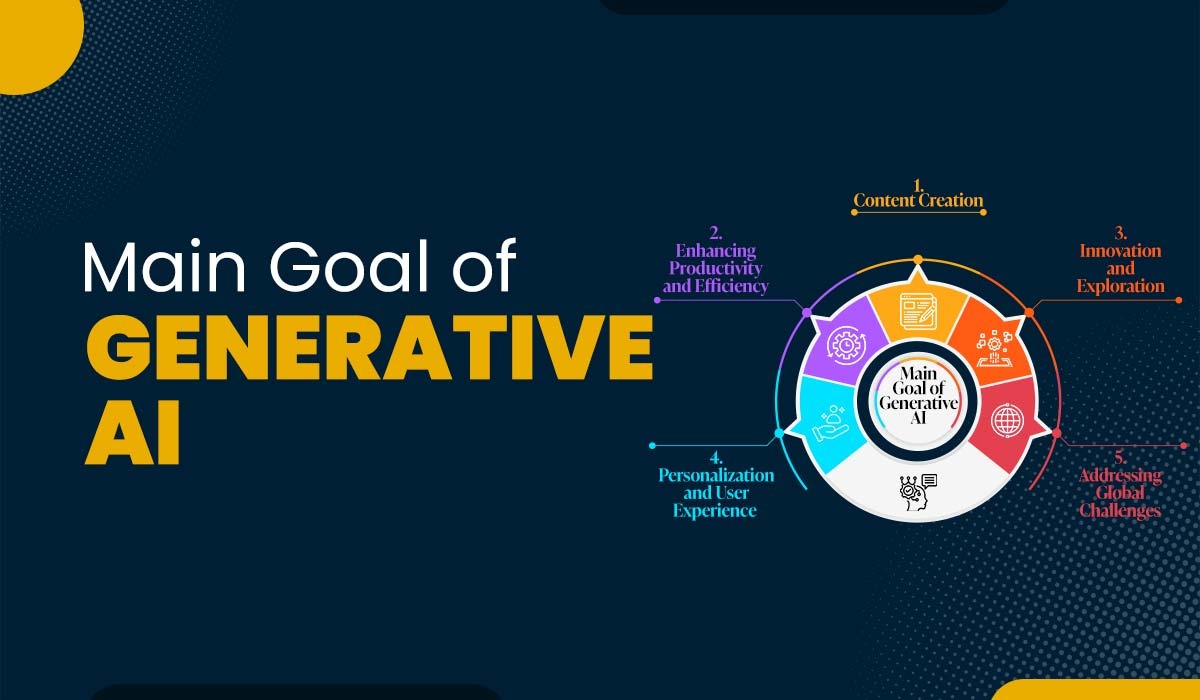Introduction
Generative AI has emerged as a transforming technology that is reshaping almost every industry. The main goal of generative AI is to create new, original content that mimics human-like creativity and problem-solving abilities. In this blog, we will discuss the objectives of generative AI, its current applications, and the future possibilities that lie ahead. By understanding the primary goal of generative AI, we can better appreciate its impact on our daily lives and prepare for the transformative changes it brings to the IT sector.
You can master Gen AI with our Generative AI Course. Before discussing the main goal of generative AI, let us first understand what generative AI is.
What is Generative AI?
Generative AI refers to artificial intelligence systems that can create new content, such as text, images, audio, and video, based on patterns and information learned from existing data. Unlike traditional AI systems that are designed to analyze and interpret data, generative AI takes a step further by producing original outputs that can be similar to human-created content.
The very basis of generative AI lies within machine learning algorithms, especially deep learning neural networks. With the help of these systems and the training they receive by using a variety of data, these types of AI are able to detect patterns and produce fresh content.
Let us now discuss the main goal of generative AI in detail.
Main Goal of Generative AI
The main goal of Generative AI is to boost human creativity, automate content generation, and improve personalization by creating original text, images, music, and other forms of data using advanced machine learning models. Below we have discussed these goals in detail:
1. Content Creation
Fundamentally, generative AI is designed to create logical, contextually appropriate, and sometimes indistinguishable from human-generated content. This main goal extends to several uses and sub-goals, all meant to push the limits of what machines can create.
Text Generation
Text creation is among the most often used applications of generative artificial intelligence. Particularly in writing human-like language across several genres and styles, AI models such as GPT-3 (Generative Pre-trained Transformer 3) have shown incredible potential. Here, the aim is to produce texts that are not only grammatically perfect but also interesting from the context.
This capability can be used for various purposes, including:
- Content marketing: Generating blog posts, social media updates, and product descriptions.
- Creative writing: Assisting authors in developing story ideas and even co-authoring novels.
- Journalism: Producing news articles and reports on data-driven topics.
- Education: Creating personalized learning materials and assessments.
Image and Art Creation
Generative AI is taking the visual arts to a whole new level. Models like DALL-E and Midjourney are able to produce beautiful images and artwork based on given text prompts. The aim is to produce custom visual content for marketing and designing, help an artist expand their imaginations, create credible visualizations in architectural and product designing, and make custom illustrations for books, magazines, and digital content.
Music and Audio Generation
Generative AIs are capable of creating original compositions and sound effects and even rendering human voices. It further helps in producing background music for video and game applications, developing new ways of personalized music, helping classical composers evolve new tunes and harmonies, and serving various applications with voices and narrations.
Video and Animation Creation
As generative AI evolves, so does its aim toward the creation of video and animated content. This comprises creating short media videos for social media promotion, creating animated characters and scenes for entertainment purposes, producing educational videos and tutorials, and helping to pre-visualize motion picture and television productions.
2. Enhancing Productivity and Efficiency
Apart from content creation, another main goal of generative AI is to enhance performance as well as productivity in different sectors. Algorithms of generative AI are designed to replace the monotonous tasks that were otherwise performed manually so that individuals can focus more on other creative tasks.
Automating Routine Tasks
Generic AI is capable of handling routine tasks, such as creating emails, reports, codes, charts, data visualization, and abstracts of long documents or research papers.
Streamlining Creative Processes
Generative AI can be applied to generate fresh design ideas that can be later improved to help writers and artists. Gen AI can come up with variations of existing ideas and product designs. Further, it can help create prototypes of individual products or interfaces for applications.
Better Decision-Making
The role of generative AI also emerges in the decision-making process, where it includes modeling multiple possibilities for strategic planning, data analysis, recommendations, generating risk simulations for decision-makers and offering advice in any kind and context, including medical and financial services.
3. Innovation and Exploration
Another primary goal of generative AI is to push the boundaries of innovation and explore new possibilities. By connecting prior knowledge in different ways, generative AI has the potential to:
Bring New Ideas
To innovate is to come up with unique ideas for creating new products and services, to suggest new approaches and methods to solve complex problems, and to combine multiple ideas in order to come up with something new. This approach challenges the traditional ways of problem-solving and brainstorming.
Accelerate Scientific Discovery
Gen AI helps in drug discovery by providing new molecular structures, using data to suggest research hypotheses, and modeling complex systems to predict their performance across several fields of study. Such efforts can reduce the time taken to conduct research and initiatives and help create advancements in the sciences and technology.
Enhance Creative Expression
Improving creativity is about expanding the range of artistic styles and techniques, blending different art forms to create unique multimedia experiences, and providing people with different ways to illustrate their ideas visually or in audio. This is a good way through which people can learn and express how artistic they can be.
4. Personalization and User Experience
Generative AI aims to transform personalization efforts, creating tailored experiences for users.
Customized Content Delivery
- Generating personalized news feeds and content recommendations.
- Creating individualized learning materials based on a student’s progress and preferences.
- Tailoring marketing messages to specific audience segments.
Adaptive User Interfaces
It can also design adaptive user interfaces that change according to the users’ habits and preferences, create virtually dynamic website layouts based on users’ responses, and develop customized avatars of virtual assistants with different characters.
Enhanced Customer Service
Within customer service, it increases value as it can create new and intelligent chatbots to answer customers’ questions regarding the product, generate responses to comments and reviews given by the customers, and construct customized product recommendations to reflect the behavior and likes of the customers.
5. Addressing Global Challenges
Generative AI helps address some of the critical problems and challenges. Below, we have discussed these issues in detail.
- Environmental Sustainability: Generative AI helps in environmental sustainability by formulating predictive models for climate change, designing more sustainable energy systems, and simulating the testing of environmental policies and their effects.
- Healthcare Advancements: Gen AI makes vital contributions to healthcare by assisting researchers in inventing innovative medical treatments and drugs. It uniquely suggests diets and treatment programs tailored for heritages and habits; it also provides efficient simulation of real-life and surgical education planning.
- Education and Skill Development: Among the various categories of education and skill development, Generative AI stands out with its most notable applications in adaptive learning content designed to help address the education challenges of skill and career development and training programs.
Now that we have discussed the main goal of generative AI. Let us now understand why ethical considerations and responsible development are critical.
Ethical Considerations and Responsible Development
While looking into the primary objective of generative AI, we should also consider the ethical considerations that come with this technology. Responsible development is one of the goals, concentrating on:
- Mitigating Bias: Generative AI attempts to mitigate bias through the creation of algorithms designed to eliminate the biases in the training data, creating representative and diverse training datasets for the AI, and creating feedback mechanisms to ensure the output is unbiased.
- Ensuring Transparency: Gen AI is capable of presenting understandable models for its decision-making, stating rules on AI-generated content usage, and having mechanisms differentiating AI and human-generated content.
- Protecting Privacy and Security: To enhance privacy and security, generative AI ensures that the system’s privacy laws and users’ rights are respected. It further appoints and employs high-security protocols against misuse of the generative AI and establishes ethical considerations on the use of personal data that we feed to the Artificial Intelligence.
Now, we have covered the main goal of generative AI and ethical considerations while using it.
Frequently Asked Questions
Q1. What is the primary goal of generative AI model?
The primary goal of generative AI is to create new content like text, images, or music.
Q2. What is the purpose of generative AI?
The purpose of Gen AI is to generate realistic and useful outputs.
Q3. What is the aim of generative research?
The aim of generative research is to improve AI creativity and problem-solving.
Q4. What are the benefits of generative AI?
Some of the benefits of generative AI are enhanced productivity, creativity, and innovation.
Conclusion
The main goal of generative AI is broad and complex. Industries can benefit by using generative AI for work such as content development, productivity improvements, global issue-solving, and more.
In this blog, we have already discussed the primary goal of generative AI, which goes beyond automating features but is rather focused on enhancement, creativity, and redefining what technology and science can achieve. With a proper understanding of the objectives of generative AI, we can create strategies to adapt to the changing future.



